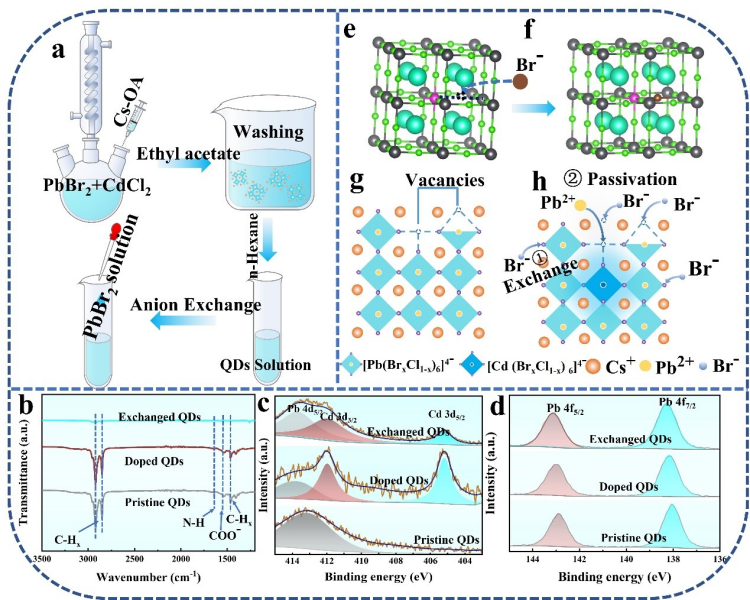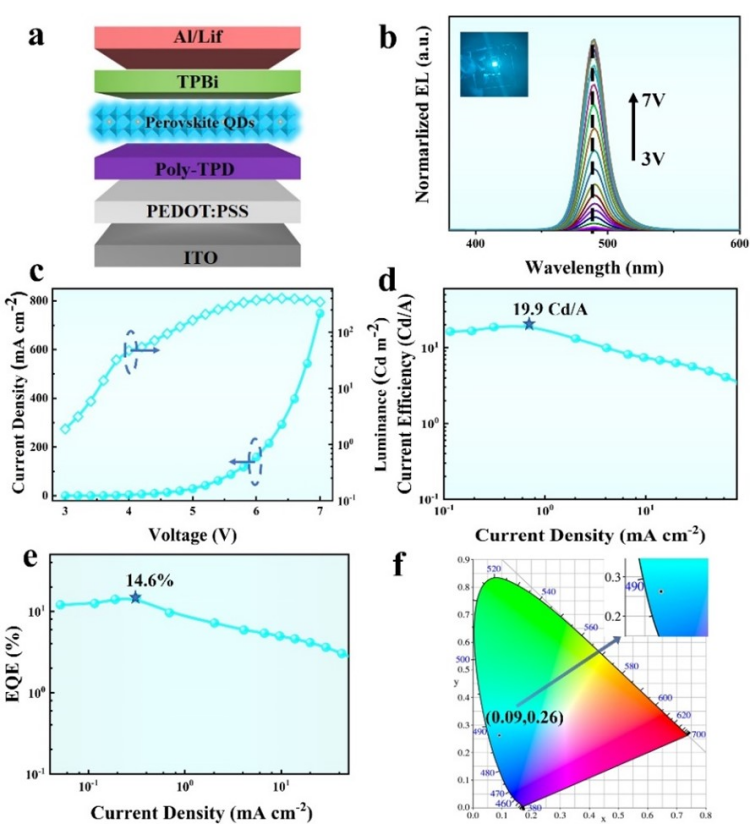Recently, the research group led by Prof. Jiang Yang from the School of Materials Science and Engineering has made a breakthrough in recording efficiency in the field of perovskite quantum-dot light-emitting diode (QLED) devices. The relevant research result "Enriched-bromine surface state for stable sky-blue spectrum perovskite QLEDs with an EQE of 14.6%" is published in Advanced Materials (Adv. Mater. 2022, 34, 2205092), an international top journal in the field of materials science.
QLEDs play an essential role in the development of next generation of new display technology. As one of promising materials in the QLEDs, perovskite quantum dots present high defect tolerance, tunable bandgap, narrow half-width and solution processed method, showing great application prospects in the field of LED display technology.However, the surface halogen vacancy and defect create the low photoluminescence quantum yieldand instability from blue perovskite quantum dots, which result in the inferior performance that the external quantum efficiency and spectral stability of blue QLEDs are far behind that of the green and red perovskite QLEDs, impeding the future development and application of the display technology of full spectrum perovskite QLEDs.
To tackle the problems mentioned above, Hanwen Zhu, a Ph.D. student majoring in Materials Physicals and Chemistry and Prof. Tong Guoqing from the research team led byProf. Jiang Yangat Hefei University of Technology started collaboration with the research group under Prof. Tang Jianxin from FUNSOM of Soochow University and proposed innovatively a strategy to deal with the problems with bromine-enriched surface state of perovskite quantum dots.According to the strategy, anion exchange is carried out in thestock solutionof cadmiumdoped-based perovskite quantum dots. It was found in the study that the doped cadmium ions can effectively reduce the formation energy of external bromine ions when filling in halogen vacancies, the excess free bromine ions in solution are enriched on the surface by anchoring in halogen vacancies as the sites, and simultaneously the long-chain ligand exchange takes placeon the surface, resulting in a bromide-rich surface state. And the surface state exhibits good passivation effect on the surface defects of the perovskite quantum dots that simultaneously increases the exciton binding energy, leading to excellent optical properties and stability.The sky-blue perovskite QLED (490 nm) prepared on this basis hit record-high external quantum efficiency of 14.6% and current efficiency of 19.9 cd/A. Meanwhile, the electroluminescence spectra exhibit negligible shift, but great stability under a constant operating voltage from 3 to 7 V. The research shows effective improvement of the external quantum efficiency and stability of perovskite quantum dot in terms of sky blue light-emitting devices, providing an effective way to solve the problems in the development of full-spectrum perovskite QLEDs and conducing to its commercial application.
The above research was supported by the National Natural Science Foundation of China, the Key Research and Development Program of Anhui Province, "Huangshan Scholar" Outstanding Young Talent Program, and the Collaborative Innovation Center of Suzhou Nano Science and Technology. Hefei University of Technology (HFUT) is the first signatory of the paper, the Ph.D. student Hanwen Zhu from HFUT is the first author, and Prof. Yang Jiang, Prof. Guoqing Tong and Prof. Jianxin Tang from Soochow University are corresponding authors of the paper.

Fig. 1 Synthesis and characterization of with cadmium-doped perovskite quantum dots, and principle of ions exchange.

Fig. 2 Performance study on the sky-blue light-emitting device prepared with perovskite quantum dots as the emitting layer



